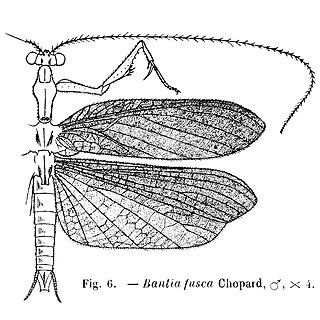
Characidae, the characids or characins is a family of freshwater subtropical and tropical fish, belonging to the order Characiformes. The name "characins" is the historical one, but scientists today tend to prefer "characids" to reflect their status as a by and large monophyletic group at family rank. To arrive there, this family has undergone much systematic and taxonomic change. Among those fishes that remain in the Characidae for the time being are the tetras, comprising the very similar genera Hemigrammus and Hyphessobrycon, as well as a few related forms such as the cave and neon tetras. Fish of this family are important as food and also include popular aquarium fish species.
Priocharax is a genus of characins, very small freshwater fish from the Amazon and Orinoco basins in tropical South America.

Aphantochilus is a genus of ant-mimicking crab spiders that was first described by Octavius Pickard-Cambridge in 1871. As of June 2020 it contains three species, found in Paraguay, Brazil, Argentina, and Panama: A. cambridgei, A. inermipes, and A. rogersi. It is a senior synonym of Cryptoceroides.

Cynodontinae is a subfamily of tropical and subtropical South American fishes of the family Cynodontidae. They are characterized by an oblique mouth and very long distinct canines, which are used to capture and stab their prey, other fish that can be up to half the length of the cynodontine itself. They are not prized as food fish, but are important in subsistence and commercial fisheries. Hydrolycus are game fish, having been recently added to the International Game Fish Association in the fly and rod class. Cynodontid fish are also sometimes housed in aquaria.
Lamontichthys is a genus of armored catfishes native to South America.

Bantia is a genus of mantises in the family Thespidae.
Acontista piracicabensis is a species of mantid in the family Acontistidae.
Bantia nana is a species of praying mantis in the family Thespidae.
Paradiabantia is a monotypic genus of praying mantises in the family Thespidae. It is represented by the single species, Paradiabantia perparva.

Thespidae is a family of insects in the order Mantodea. Following a major revision of this order in 2019, the old-world subfamilies Haaniinae and Hoplocoryphinae, previously placed here, have been upgraded to family level. Many genera are Neotropical, but the Thespinae are represented in Africa, Asia, Europe, and North America.

The Phaneropterinae, the sickle-bearing bush crickets or leaf katydids, are a subfamily of insects within the family Tettigoniidae. Nearly 2,060 species in 85 genera throughout the world are known. They are also known as false katydids or round-headed katydids.

Chalceus is a genus of fish that inhabits freshwater habitats in South America. Members can be found in the Amazon and Orinoco basins, as well as in the Guianas and various tributaries of the former. It is the sole representative of the family Chalceidae.

Cynodon is a genus of dogtooth characins from tropical South America, including the Amazon and Orinoco basins, and rivers in the Guianas. These predatory fish reach up to 32.2 cm (1.06 ft) in standard length. They are mainly piscivorous, but will also take insects.

Hydrolycus is a genus of large dogtooth characins from tropical South America, where found in the Amazon and Orinoco basins, as well as rivers of the Guianas. The genus includes the largest dogtooth characins, reaching up to 1.17 m (3.8 ft) in length. They have long, pointed teeth used for spearing their prey, generally smaller fish. In a study of the stomachs of 45 individuals, most were empty, but among the remaining the prey fish were 15–50% of the length Hydrolycus itself.
Cynodon septenarius is one of three species of dogtooth characins in the genus Cynodon. It is the most recently described member of its genus. This fish is found in tropical fresh waters of South America, including the Amazon and Orinoco basins, and rivers in Guyana.

The 2013 presidential primary of the Social Christian Unity Party of Costa Rica was held on May 9, 2013, as part of the 2014 Costa Rican general election. The two main traditional factions of PUSC competed for the nomination. The competing parties were Costa Rica's Children's Hospital Dr. Rodolfo Hernández, and the lawyer, businessman, and former president of the Costa Rican Social Security Fund Rodolfo Piza. This was PUSC's fifth primary election in its history and the first in twelve years.

Evaristo de Toledo Piza is a Brazilian football coach and former player who played as a midfielder.

Chalceidae, the tucanfishes, is a family of freshwater fish first described by Henry Weed Fowler in the year 1958. It is a monotypic family, home only to the genus incertae sedisChalceus.

Chalceus guaporensis is a species of freshwater fish in the family Chalceidae that inhabits northern South America. Alongside C. epakros and C. spilogyros, it was added to the genus Chalceus in the year 2004.
Chalceus spilogyros, sometimes misspelled as Chalceus spilogyrus, is a species of freshwater fish in the family Chalceidae that inhabits northern South America. It is a relatively new member of the genus Chalceus, along with C. epakros and C. guaporensis.











